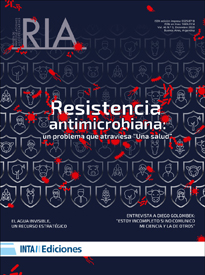Ver ítem
- xmlui.general.dspace_homeCentros Regionales y EEAsCentro Regional CórdobaEEA Marcos JuárezArtículos científicosxmlui.ArtifactBrowser.ItemViewer.trail
- Inicio
- Centros Regionales y EEAs
- Centro Regional Córdoba
- EEA Marcos Juárez
- Artículos científicos
- Ver ítem
Efecto del arreglo espacial de mijo perla en ambientes halo-hidromórficos
Resumen
La captación de recursos por parte de las diferentes especies está condicionada en gran medida por la
disponibilidad de estos en el ambiente y por la distribución de los individuos en el espacio; esta última puede modificarse a partir de diferentes combinaciones de espaciamiento entre hileras y densidades de siembra. El objetivo del trabajo fue determinar con qué arreglo espacial se obtiene el mejor establecimiento y acumulación de biomasa de mijo perla
[ver mas...]
La captación de recursos por parte de las diferentes especies está condicionada en gran medida por la
disponibilidad de estos en el ambiente y por la distribución de los individuos en el espacio; esta última puede modificarse a partir de diferentes combinaciones de espaciamiento entre hileras y densidades de siembra. El objetivo del trabajo fue determinar con qué arreglo espacial se obtiene el mejor establecimiento y acumulación de biomasa de mijo perla en ambientes halo-hidromórficos. Así, durante las etapas de establecimiento temprano (450ºCd) el incremento en la densidad de siembra de mijo perla aumentó la densidad de individuos (plantas.m-2) hasta densidades de 18 kg.ha-1, diluyéndose hacia la primera acumulación (750ºCd) y hallando una meseta en la densidad de macollos con densidades de siembra de 12 kg.ha-1; sin embargo no se halló ninguna diferencia entre las densidades utilizadas en la segunda acumulación (1450ºCd). No se encontraron diferencias durante el crecimiento temprano en el tamaño de individuos o en la biomasa acumulada entre las diferentes densidades de siembra utilizadas; tampoco se hallaron diferencias en la densidad de plantas durante el establecimiento temprano para los diferentes espaciamientos entre hileras, aunque se encontraron posteriormente en ambas acumulaciones que aquellos tratamientos sembrados a mayor distancia entre hileras (40 cm) presentaron mayor biomasa acumulada y peso de sus componentes de rendimiento, respecto de aquellos sembrados con menor espaciamiento (20 cm). No es recomendable para mijo perla reducir el
espaciamiento entre hileras en ambientes con limitantes hídricas y salinas.
[Cerrar]
The capture of resources by different species is conditioned to a large extent by their availability in the environment and by the distribution of individuals in space, the latter can be modified from different combinations of rows spacing and seeding rate. The objective of the work was to determine with what spatial arrangement the best establishment and growth of pearl millet biomass in halo-hydromorphic environments is obtained. Thus, during the
[ver mas...]
The capture of resources by different species is conditioned to a large extent by their availability in the environment and by the distribution of individuals in space, the latter can be modified from different combinations of rows spacing and seeding rate. The objective of the work was to determine with what spatial arrangement the best establishment and growth of pearl millet biomass in halo-hydromorphic environments is obtained. Thus, during the establishment stages, the increase in seeding rate of pearl millet increased the density of individuals (plants.m-2), up to densities of 18 kg.ha-1, during the early establishment (450ºCd), diluting to the first growth (750ºC), finding a plateau in the density of tillers with seeding rate of 12 kg.ha-1, finding no difference between the densities used in the second growth (1450ºC). No differences were found during the early growth in the size of individuals or in the biomass accumulated between the different seeding rate used, nor were differences found in the density of plants during the early establishment for the different rows spacing, finding later in both accumulations, those treatments planted at a greater distance between rows (40 cm) had greater accumulated biomass and weight of their yield components, compared to those planted with less spacing (20 cm), not being recommended for pearl millet to reduce rows spacing in environments with water and salt limits.
[Cerrar]

Fuente
RIA 46 (3) : 314-322 (Diciembre 2020)
Fecha
2020-12
Editorial
Ediciones INTA
ISSN
0325-8718
1669-2314
1669-2314
Formato
pdf
Tipo de documento
artículo
Palabras Claves
Derechos de acceso
Abierto
 Excepto donde se diga explicitamente, este item se publica bajo la siguiente descripción: Creative Commons Attribution-NonCommercial-ShareAlike 2.5 Unported (CC BY-NC-SA 2.5)
Excepto donde se diga explicitamente, este item se publica bajo la siguiente descripción: Creative Commons Attribution-NonCommercial-ShareAlike 2.5 Unported (CC BY-NC-SA 2.5)


